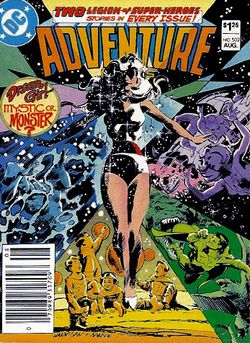Adventure Comics 502
| ||||||||||||||||||||||||||||||
Background
Adventure Comics was the birthplace of the Legion and its longtime home. After almost 500 issues of publication, it became primarily a series of reprints. Featured each month was a chronological re-presentation of the Legion's earliest tales, two in each issue, beginning with their first appearance.
Reprinted material
Original publication source is noted for each.
- Plastic Man, untitled story - Adventure Comics #470 (April, 1980)
- The Legion in "The Renegade Super-Hero!" – Adventure Comics #316 (January, 1964)
- Captain Marvel and "The Human Hawks" – Captain Marvel Adventures #143 (April, 1953)
- The Spectre in "The Parchment of Power Perilous" – The Spectre #8 (January/February, 1969)
- Aquaman in "The City on the Edge of Nowhere" – Aquaman #50 (March/April, 1970)
- Zatana, untitled story - Adventure Comics #413 (December, 1971)
- The Legion in "The Menace of Dream Girl!" – Adventure Comics #317 (February, 1964)
The Story Behind the Stories
The two Legion reprints included in each issue of the digest-sized Adventure Comics were the feature attraction. As an added bonus to Legion fans, a running commentary about that issue's reprinted Legion stories was provided each month by Paul Levitz, who was the writer of the Legion's current series while the Adventure digests were being produced. Years later, these commentaries are the primary point of interest (other than the reprinted stories themselves), so the full text is provided below:
